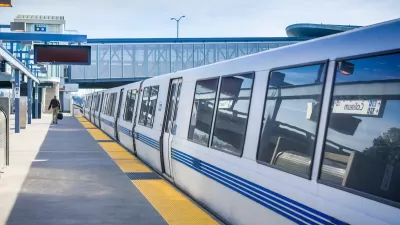As attention to energy efficiency and climate change continue to pervade the thinking and planning of the future transportation system, we are increasingly challenged to make very real decisions about the prudence of various investments. The current context for decision-making offers perhaps the greatest uncertainty regarding the future witnessed in the lifetimes of people in the planning profession today.
As attention to energy efficiency and climate change continue to pervade the thinking and planning of the future transportation system, we are increasingly challenged to make very real decisions about the prudence of various investments. The current context for decision-making offers perhaps the greatest uncertainty regarding the future witnessed in the lifetimes of people in the planning profession today. The fundamentals of planning; forecasting future population and its geographic distribution, forecasting travel behaviors and needs, and understanding the performance, impacts, and costs of the investments and service options that can be pursued, are particularly challenging at this point in time. Economic uncertainties, perhaps the most severe since the Great Depression, exacerbate risks. Yet, decision makers are facing very real decisions that require trade-offs between accomplishing desired objectives and addressing the economic reality that burdens those policy decision makers still challenged with that nasty job of having to live within a budget.
The public transportation industry is faced with a whole range of such trade-offs. One particular decision involves determining whether to purchase hybrid buses as an alternative to clean diesel buses. This is a particularly frustrating decision because it pits good intentions against fiscal common sense. It exemplifies the very real challenges that confront communities as they attempt to address energy and climate change concerns. The frustration stems from the fact that we appear to have to make a trade-off between environmental sustainability and financial sustainability. In the ideal world these would be complementary objectives - energy efficiency would implicitly be resource efficient and lower cost. In reality, at this point in time and technological progress, energy and environmental sustainability jeopardizes financial sustainability.
Hybrid buses are a classic case in point. These vehicles are often prescribed claims and expectations of significant improvements in energy efficiency but have often struggled to deliver double digit percentage improvements. A 20 percent improvement sounds good until one realizes that capital cost differences are more in the neighborhood of 60 to 100%. While there are certainly different types of hybrid technologies and numerous factors that influence the resultant performance (weather, topography, nature of bus route, driver training and experience, mechanical condition, etc.) and cost, the bottom line is that the economic payback from such an investment is not accomplished within the life of the vehicle. In fact, some back-of-the-envelope calculations for some Florida applications suggest it might take two or three vehicle lifetimes for there to be an economic payback from hybrid vehicles – an obvious impossibility in the real world. While such investments might still offer positive public image benefits and be motivational for staff, to rationalize such an investment requires placing an extraordinary premium on the energy and climate change benefits well beyond those reflected in the current pricing of energy. And even this logic begs the issue of whether or not this is the most efficient way to gain those energy savings and carbon emissions benefits.
Interestingly, a quick review of a mixed sample of domestic hybrid cars, trucks, and SUVs indicates a cost difference for hybrid products of approximately 20% and a difference of nearly 33% in terms of energy efficiency (mpg). Forty foot diesel coaches, on the other hand, appear to be delivering energy efficiency improvements of under 20% and still carry cost premiums over 60%. In fact, some paratransit sized vehicles with hybrid power trains can cost twice as much as non-hybrid vehicles.
This situation begs a number of questions.
· Why are the price and performance differences between diesel coaches and light vehicles so large when it comes to the impact of hybridization?
· Are there fundamental advantages for light vehicles in adapting and amortizing development costs of hybrid technology compared to transit vehicles?
· Is pricing of hybrid vehicles governed by true cost differences or based on leveraging the emotional appeal of the "green" technology and taking advantage of the fact that public-sector decision-makers often struggle with cost-effectiveness trade-offs?
The trade-off on whether or not to buy hybrid diesel coaches is only one tangible example of the complex set of choices facing decision-makers regarding future transportation policy and service investments. The public and decision-makers are being inundated with a host of initiatives and programs wrapped in the cloak of sustainability. Many of these proposals are far from financially sustainable and their contributions to environmental sustainability are not yet founded on reliable empirical evidence nor shown to be an efficient means of attaining energy savings or carbon emissions benefits.
How much green, should we pay for "green"? Do we have to trade off financial sustainability for environmental sustainability? Is anyone watching closely?

Planetizen Federal Action Tracker
A weekly monitor of how Trump’s orders and actions are impacting planners and planning in America.

Map: Where Senate Republicans Want to Sell Your Public Lands
For public land advocates, the Senate Republicans’ proposal to sell millions of acres of public land in the West is “the biggest fight of their careers.”

Restaurant Patios Were a Pandemic Win — Why Were They so Hard to Keep?
Social distancing requirements and changes in travel patterns prompted cities to pilot new uses for street and sidewalk space. Then it got complicated.

Albuquerque Route 66 Motels Become Affordable Housing
A $4 million city fund is incentivizing developers to breathe new life into derelict midcentury motels.

DC Area County Eliminates Bus Fares
Montgomery County joins a growing trend of making transit free.

Platform Pilsner: Vancouver Transit Agency Releases... a Beer?
TransLink will receive a portion of every sale of the four-pack.
Urban Design for Planners 1: Software Tools
This six-course series explores essential urban design concepts using open source software and equips planners with the tools they need to participate fully in the urban design process.
Planning for Universal Design
Learn the tools for implementing Universal Design in planning regulations.
Heyer Gruel & Associates PA
JM Goldson LLC
Custer County Colorado
City of Camden Redevelopment Agency
City of Astoria
Transportation Research & Education Center (TREC) at Portland State University
Camden Redevelopment Agency
City of Claremont
Municipality of Princeton (NJ)




























